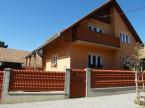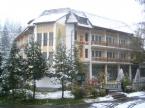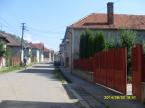Information
Baia Mare (meaning Great Mine, pronunciation in Romanian:
- name in Hungarian: Nagybánya, German: Frauenbach and seldomly Neustadt) is an important city in northern Romania and the seat of Maramureş County. It is located in the western part of the county, on the middle course of the Sasar River, at an average altitude of 228 metres. The city has an area of 235.73 km² and also contains the following settlements: Blidari, Firiza, Valea Neagră and Valea Borcutului.
Population
The municipality of Baia Mare has a total population of 137,921, the city is home to a sizeable Hungarian community. The ethnic composition of the city is as follows:
- Romanian: 114,213 (82.81%)
- Hungarian: 20,467 (14.84%)
- Roma: 2,092 (1.51%)
- German: 507 (0.36%)
Politics
The Baia Mare Municipal Council, elected in the 2004 local government elections, is made up of 23 councillors, with the following party composition:
History
During the Bronze Age, the region around Baia Mare was the realm of the Thracians, from whom the Geto-Dacians later descended. It was also part of the large Dacian state formed by Burebista.The first mention of the settlement is from 1142, when King Géza II of Hungary settled it with Transylvanian Saxons. The name of the settlement was Frauenbach in German (Asszonypataka in Hungarian, Rivulus Dominarum in Latin), meaning “River of the Ladies” or “Women's Brook”. The richest documentation, however, is found in the act of privilege issued by Louis I of Hungary in 1347.In 1411 the Hungarian king exchanged the city for Belgrade with Djuradj Branković, prince of Serbia (from 1411 to 1521 Belgrade was a Hungarian border castle). A document from that year speaks of the Mint in Baia Mare, one of the oldest and most famous in Transylvania.
In 1446 the mines and domain of Baia Mare become the property of the Hunyadi family as a token of gratitude for the bravery shown by John Hunyadi in his battles against the invading Turks. John Hunyadi commissioned the Saint Stephen cathedral whose Stephen Tower remains a landmark of the city to this date.
In 1469 King Matthias Corvinus of Hungary bestowed upon the city the right to develop its defense system by erecting fortified walls and keeps, strengthened by deep moats and large palisades to keep out the invaders. Baia Mare thus became an impressive fortress.
In 1567 it was annexed by John Szigmond, prince of Transylvania. The city was in Szatmár County of the Kingdom of Hungary.
In 1600, as a sign of gratitude for having cancelled several of the city's debts, the tenant of the local mines, Felician Herbstein, ordered a coin to be minted in gold, displaying the effigy of Michael the Brave, voivod of Wallachia. Collectors agree that this is an effigy of the prince of great numismatic value.
Between the years 1605 and 1606, 1621 and 1629, and 1645 and 1648, the city and the surrounding county was part of the Principality of Transylvania. From the 16th century the settlement was officially called Nagybánya.
In 1703, the legendary outlaw Pintea Viteazul was witness, alongside Francis II Rákóczi, to the freeing of the city from the hands of the Austrian Habsburgs during a kurucs war. The year 1889 saw the printing of the first newspaper in the Romanian language - "Gutinul" - a weekly paper dealing in social, literary and economic matters.In 1910 the town had 12877 inhabitants: 9992 (77,6%) Hungarians, 2677 (20,8%) Romanians, 175 (1,4%) Germans.<ref>Atlas and Gazetteer of Historic Hungary 1914, Talma Kiadó</ref>
From 1919/1920 (Treaty of Trianon) to 1940 (Second Vienna Award), Baia Mare was part of the Kingdom of Romania, and during 1940-1944 part of Hungary. The Treaty of Paris after the Second World War returned the city to Romania. From 1952 to 1960 Baia Mare was in the Baia Mare Region, from 1960 to 1968 in the Maramureş Region, and since 1968 has been in Maramureş County.
Gallery
<center><gallery>Image:001.1024.jpg|Downtown Baia Mareimage:turnulStefan.jpg|St. Stephen's Towerimage:prefecturabm.jpg|The County Hallimage:Hotelul_mara.jpg|Mara Hotelimage:traianbd.jpg|Traian Boulevardimage:Ostasul.jpg|The Romanian Soldier Monument</gallery></center>
References
<references/>

 English
English









